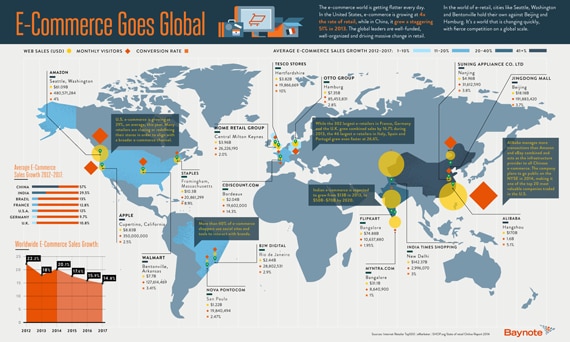One of the keys to E-commerce are Internet marketing, automated data collection systems and mobile commerce. Mobile shopping retail sales in the US are currently $70 billion worth. Goldman Sachs Group Inc. projects a growth to $173 billion by the end of 2018. The retail sales through the tablet are expected to tripple in 2018.
The research shows that nearly half of the smartphone users have consulted their phones to find store info, such as location and working hours. For retailers, a huge opportunity exists in how consumers use their mobile devices while they’re in the store. The percent of total sales will jump from 2014’s 19% to 2018’2 29%, making E-commerce practically the 1/3 of all retail sales in general.
How One AI-Driven Media Platform Cut EBS Costs for AWS ASGs by 48%

This shows that online retailers should focus on:
- Optimizing the tablet and smartphone experience – Pushing a desktop optimized site to a tablet experience simply won’t cut it. Retailers need to invest in this area or risk chances of the associated revenue and customer engagement.
- Connecting stores with mobile marketing – Using SMS to offer coupons to drive store traffic has met with success in tests by companies like Staples and Ace Hardware.
- Marketing customer “must have” services such as inventory stock availability – a recent study by Hybris found almost three-quarters of shoppers rate inventory visibility as “critical to their purchase decisions”. Basically,if you don’t have inventory stock availability, you’re already way out of the game and you should catch up.
Of the 219.4 million internet users in the US ages 14 and older, eMarketer expects 196.6 million, or 89.6%, to shop online this year, compared with 163.2 million who will go on to complete a purchase digitally. This makes E-commerce a huge opportunity for any given retailer company with a great mobile site.
The same Accenture study found that 72% of respondents “showroomed,” or bought digitally after seeing a product in a store. Consumers, then, have merged online and offline into a single shopping experience. The largest E-commerce growth is reported in China and India, while the countries such as Germany, France, UK, USA and such have the slowest growth compared to the countries where the Internat market is still developing, which is logical. Indian E-commerce is expected to grow from nowdays’ $13 billion to $50-$70 billion in 2020. Research also shows that more than 60% of retailers use social sites such as Facebook to market their products and start a customer interaction. Retailers should test their mobile sites (and optimize mobile website performance) and always be two steps ahead.

World According to Ecommerce by Baynote. Image source
A very significant phenomenon developed in 2013: consumers who only use mobile devices (smartphones and tablets) to shop online.
- 3% of online shoppers are mobile-only, comScore finds.
- 53% of all US mobile web/app users accessed Amazon.com’s m-commerce site. For more on the mobile e-commerce trends and research go to eMarketer.
E-commerce and digital marketing teams increasingly understand that they need to drive sales in a channel-agnostic way. Scott Falzone, industry director of retail specialty at Google, noted that particularly among multichannel retailers, “their interest in digital is increasingly focused on driving customers and shoppers into their store locations as well as continuing to have a growing ecommerce and mobile commerce presence.”
E-retail reports 2009-2016 suggest a steady growth:
- US social commerce sales of physical goods through online social networks are projected to grow by 93% per year in the US, reaching $14 billion by 2015. The report is based on a survey in 2010 by the research and consulting firm Booz & Co, basically saying that 27% of shoppers are willing to buy through social media.
- Brazil’s online retail market is expected to increase by a compound annual growth rate of 17.5%over the next 5 years, meaning that the online sales will go up to $22 billion in 2016, putting it on an impressive growth rate, since it was only $7.9 billion worth 4 years ago.
- A research by the Forrester Research Co. also shows that the online retail sales in Europe for the last 6 years are constantly growing, but in a slower rate than Brasil’s online market. It grew from US $112.1 billion in 2010 to $184.6 billion by 2015, which rounds up to an annual growth rate of 10%. The number of online shoppers in the 17 European Union nations will grow from 275 million to 303 million by the end of 2015.
- On a global scale, e-commerce sales are growing more than 19% a year.
As of 2014, worldwide retail sales are more than $1 trillion worth, and are growing at a steady 19.4% annualy. E-commerce is growing every year, slowly wiping out traditional ways of purchase. Buying things online is simply more and more handy, giving consumers more insight to what they’re buying and practically delivering it to their doorstep. Traditional retailers need to step up and boost their online services and go full mobile, but that’s just the beginning – desktop and mobile websites need to be as fast as possible to meet the expectations of their visitors, otherwise, conversion rates, user experience and overall brand satisfaction can cause serious harm to sales and ROI.
As a final note, we bring two fantastic presentations about the future of mobile commerce and how internet / mobile / ecommerce consumption will change in the next decade. The question that still hangs in the air for all e-commerce owners: Are you ready for mobile shoppers? Or more important: Is your mobile store fast enough to satisfy your shoppers?
The Emerging Global Web from yiibu
Reset the Web from yiibu

About GlobalDots
With over 10 years of experience, GlobalDots have an unparallel knowledge of today’s leading web technologies. Our team know exactly what a business needs to do to succeed in providing the best online presence for their customers. We can analyse your needs and challenges to provide you with a bespoke recommendation about which services you can benefit from.
GlobalDots can help you with the following technologies: Content Delivery Network, DDoS Protection, Multi CDN, Cloud performance optimization and infrastructure monitoring.






